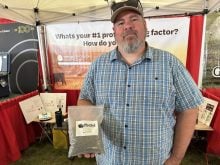In previous Grainews issues, I have discussed how to develop nitrogen (N) and phosphorus (P) fertilizer recommendations. In this issue, I will focus on the development of potassium (K) fertilizer recommendations.
Most crops take up potassium in relatively high amounts, often similar to nitrogen. About 25 to 30 per cent of Prairie soils are estimated to have slight to moderate potassium deficiency. Over the past 50 years of cropping, soil potassium levels have been slowly declining.
Read Also

Gentle treatments for pain in the neck
Heading toward year-end, people unknowingly tense up against the cold and busyness, causing neck pain that can often be treated with appropriate support and gentle mobility, athletic therapist Kathlyn Hossack says.
Potassium deficiency across the Prairies is less common than nitrogen, phosphorus, or sulphur deficiency. In Alberta, about 75 per cent of cultivated soils have extractable soil potassium levels in the range of 400 to more than 800 pounds of potassium per acre in the top six inches of soil, which is more than adequate to achieve optimum crop production. Loam- to clay loam-textured Prairie soils in Western Canada typically have a total potassium content of 40,000 to 50,000 pounds per acre or more in the top six inches of soil, but only one to two per cent of this potassium is available to plants, the remainder is locked within clay minerals.
As mentioned, only about 25 to 30 per cent of Prairie soils are marginal to deficient in soil potassium, and there are two reasons for this. Potassium is contained in clay minerals. Medium- and fine-textured soils contain a significant amount of clay and as the edges of clay minerals weather and break down, plant-available potassium is released into the soil to recharge available and exchangeable soil potassium levels. Also, about 75 to 80 per cent of the potassium taken up by cereal, oilseed and pulse crops remains in the vegetative plant material. As long as the crop residue is returned to the soil, most of the potassium taken up by plants during the growing season is returned to the soil.
When potassium deficiency occurs in crops, it results in reduced vegetative growth, delayed maturity, increased lodging caused by weaker stems and lower bushel weight. Potassium deficiencies tend to occur more commonly in sandy-textured soils that are intensively cropped. Deficiencies can be corrected with potassium chloride (potash) fertilizer.
Typically, only one to two per cent of the total potassium in soil is available or exchangeable to plants. Potassium in soil solution and in exchangeable form occur as a positively charged ion (K+). The plant-available potassium is dissolved in soil water for uptake by plants. The exchangeable potassium is attached to negatively charged exchange sites on the surface of clay particles. As plant roots take up the available potassium dissolved in the soil water, exchangeable potassium is released into the soil solution to maintain an equilibrium between the two forms.
The potassium soil test attempts to measure both the available and exchangeable potassium in soil to determine the ability of soil to supply potassium for optimum crop production. The combined available and exchangeable levels of soil potassium generally range between 50 and 1,000 pounds per acre in the top zero to six inches of soil. Many years of field research has shown that a minimum of 250 pounds per acre of potassium in the top six inches of soil is generally required for adequate growth of most cereal, oilseed and pulse crops.
It is important to note potassium only occurs in soil in inorganic form. The potassium element does not occur in soil organic matter. As mentioned, potassium has one positive charge, therefore, soil potassium tends to be fairly immobile in soil and normally is not subject to leaching or downward movement in soil.
Potassium deficiencies on the Prairies typically occur more frequently on coarse- (sandy) to medium-textured (loam) soils in the black, dark grey and grey soil zones, as well as organic soils. Soil testing is very useful to determine the need for potassium fertilizer application.
Crop potassium requirements
Most potassium taken up by plants remains in the leaves and straw with only a small portion of potassium in the seed. Table 1 (below) shows the typical potassium content of seed and straw of some annual crops. Potassium removal from the soil is relatively low as long as only the grain is removed from the field and the rest of the plant residue is left in the field.

Soil potassium removal is much higher from fields when forage or silage crops are grown and all above-ground biomass is removed from the field. However, if the forage is fed to livestock on the farm, and the manure is returned to the fields, most of the potassium will also be returned to the soil that was removed by the forages.
It is important to be aware of the amount of potassium removed by various crops (see Table 1) but this should not be the basis for determining potassium fertilizer requirements. Most Prairie soils contain adequate to high levels of plant-available potassium and can supply adequate potassium, even for high-use crops. On soils that test deficient in potassium, potassium fertilizer is needed to maintain adequate plant nutrition.
Potassium fertilizer requirements
Soil testing is the best way to determine the need for potassium fertilizer. Crop response to potassium fertilizer has been correlated with the amount of soil potassium extracted using either the ammonium acetate extraction method or the modified Kelowna method, which includes ammonium acetate in the extractant.
Some labs and agronomists use base cation saturation to look at ratios of potassium with magnesium and calcium to develop potassium fertilizer recommendations. This is a flawed method to determine potassium fertilizer requirements and is not recommended for use in Western Canada. (For more information see the Nov. 10, 2015, issue of Grainews, page 25, where I explain the usage of base cation saturation rations.)
All soil test potassium correlation research work done in Western Canada has been with the zero- to six-inch sampling depth. Always sample the zero- to six-inch depth separately from deeper depth samples to accurately determine potassium fertilizer requirements.
In field studies with barley in Alberta, all research sites responded to potassium fertilizer when the soil test potassium level was less than 50 pounds per acre. On soils with 100 to 150 pounds per acre of extractable potassium, 66 per cent of sites responded to potassium fertilizer. And on soils with 150 to 200 pounds per acre of extractable potassium, 24 per cent of sites responded to potassium.
The probability of barley response to potassium above a soil test level of 250 pounds per acre is less than five per cent. When soil test potassium levels are between 250 and 300 pounds per acre, producers could consider a maintenance application of 15 to 30 pounds of K2O (potassium oxide) per acre to help replace potassium taken up and removed by crops. This application could also potentially increase crop yield in areas of the field that may have slightly deficient soil potassium levels.
Tables 2 and 3 (below) show potassium recommendations for cereal crops and oilseed crops at various soil test potassium levels in each soil zone for Alberta. The recommendations are from the Alberta Agriculture publication Agdex 542-9 Potassium Fertilizer Application in Crop Production.


As an example, for a field in the dark grey soil zone with a soil potassium level of 140 pounds of potassium per acre, in the zero- to six-inch depth that would be seeded to wheat, the potassium fertilizer recommendation would be to apply 50 to 70 pounds of K2O per acre. Saskatchewan and Manitoba farmers can access their provincial agricultural websites for specific potassium recommendations.
When soil test potassium levels are in the very deficient range (see Table 2 above), the probability of crop response is greater than 75 per cent, based on many years of field research in Alberta. When the soil test values are in the moderately deficient range, the probability of crop response is between 15 and 25 per cent. When soil test potassium is greater than 250 pounds of potassium per acre, the probability of crop response is less than five per cent. A response to potassium fertilizer is unlikely when the soil test level for potassium is in the adequate range.
It is important to remember that potassium is not mobile in soil. As a result, placement of potassium fertilizer with or near the seed is often the most effective application method. However, potassium chloride fertilizer (KCl, 0-0-60) has a relatively high salt index. When placed with the seed, a “salt effect” can cause reduced seed germination and emergence. The salt effect of fertilizer limits water uptake by the seed and results in injury or death of germinating seeds. Great care is needed when potassium fertilizer is seed-placed either alone or in combination with phosphate and/or sulphate fertilizers.
Many Prairie farmers seed-place the optimum amount of phosphate and side or mid-row band potassium and other fertilizers to avoid salt injury to their crops. This is a good method of applying potassium, particularly when higher rates of potassium must be applied. Side banded fertilizer should be at least 1.5 inches to the side and, preferably, about 1.5 inches below the depth of seeding to avoid salt injury to a crop but placed for easy uptake by plant roots.
When soils are very deficient in potassium and higher potassium fertilizer rates are needed, banding prior to seeding is a good option to consider. This placement method should provide similar results to side banding potassium and is more effective than broadcast incorporation. Broadcast incorporated application of potassium fertilizer can be used to build up soil potassium levels in very potassium-deficient soils.
















